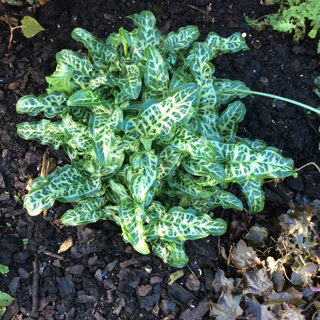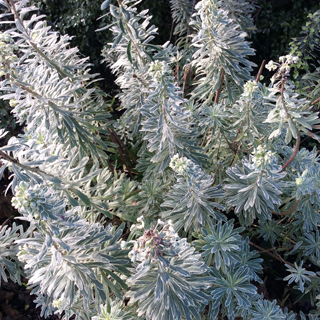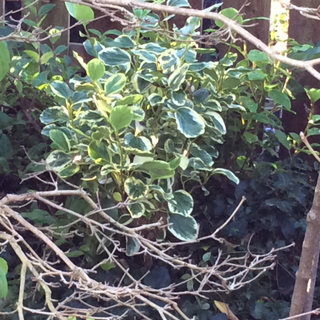 So what’s your New Year resolution? No more chocolate, less alcohol, take up jogging, lose weight? How about adding a more positive one – do more gardening. It’ll take your mind off the fact that you can’t keep to the others and make you feel better at the same time. It works for us!
So what’s your New Year resolution? No more chocolate, less alcohol, take up jogging, lose weight? How about adding a more positive one – do more gardening. It’ll take your mind off the fact that you can’t keep to the others and make you feel better at the same time. It works for us!
We are still in that period where winter conditions should prevent us from doing too much in the garden; we’re feeling a bit cheated out of crisp, cold, winter days, to be honest . We say should, because the temptation, with these elevated temperatures (about 13 degrees during the day at the time of writing) is to chop and snip and dig as if it were early spring. It isn’t spring though, so proceed with caution with whatever you do, however much you feel the urge to make use of the odd dry day.
 We could get a cold snap any time, and we probably won’t get much warning. Give some thought to how each plant you are threatening with your tools might react if you got frost the following night. If the answer is not ‘fine”, then leave well alone.
We could get a cold snap any time, and we probably won’t get much warning. Give some thought to how each plant you are threatening with your tools might react if you got frost the following night. If the answer is not ‘fine”, then leave well alone.
These conditions are really unusual though – there were reports 2 weeks before Christmas of a lady in Hampshire with 31 plants in bloom in her garden (I can beat that – Helen) which is great, but plants need to rest. If you have lots in bloom out of season, think about giving them an extra feed in the spring. Otherwise, they will be worn out and possibly not bloom so well for you next year.
One way of preventing you fiddling too much in your own garden is to use those drier days to visit other gardens, and see how their winter displays are performing. It could give you ideas on how to fill the winter gaps in your own garden. RHS Rosemoor still has plenty to see at this time of year, as do many of the more tropical gardens on the Roseland, in the Helford area, and West Cornwall. Take a pen and notepad and get some ideas.
One way we think you can really lift your garden at this time of year is with variegation. We realise some gardeners are philosophically opposed to variegated plants either because their colouring is not deemed pure enough, or because the variegation can produce weaker strains. In fairness, some do but that is a generalisation that will have you missing out on some great plants, if you apply a blanket rule.
 Variegated plants can really shine a light into dull winter corners with minimal effort, and when we do get a little winter sun, they beam. There are some beautiful white euphorbias such as Silver Swan and Tasmanian Tiger that are simply luminescent at this time of year and require minimal care.
Variegated plants can really shine a light into dull winter corners with minimal effort, and when we do get a little winter sun, they beam. There are some beautiful white euphorbias such as Silver Swan and Tasmanian Tiger that are simply luminescent at this time of year and require minimal care.
Don’t put off by the suggestion that euphorbias are very poisonous – many things in the garden are, if you eat them – but if you have sensitive skin, simply wear gloves and avoid getting the sap on your bare skin and you will be fine.
Another plant with a lovely variegated version is holly, which of course is invaluable in the garden and as a cut foliage at this time of year. Look for a female variety or a self-fertile one is you want berries, but don’t be misled by the names. There are some female varieties with male names and vice versa – just to confuse matters. Good garden centres will be able to recommend a variety to suit you. Note that if you have a female variety, you will need a male variety nearby to pollinate it, before it will produce berries.
Griselinia is another shrub which has a lovely variegated variety – great for hedging, either on its own, or mixed with other evergreens. Just be prepared to control it with a chair and a whip though, as in our mild climate, it does have a tendency to romp away. Luckily though, it is eminently controllable and responds well to even a very hard prune.
Pitto sporum is another shrub which is hardy in the Cornish climate, and has some wonderful variegated varieties which simply glow – try P. Irene Patterson or Garnettii for a white variegation, or P. Elizabeth for white variegation with a pink tinge – very pretty. Pittosporum has the added benefit of a delicious scent from tiny, dark, almost unnoticeable with the eye, flowers, but your nose will certainly pick it up without any trouble. It will stop you in your tracks.
sporum is another shrub which is hardy in the Cornish climate, and has some wonderful variegated varieties which simply glow – try P. Irene Patterson or Garnettii for a white variegation, or P. Elizabeth for white variegation with a pink tinge – very pretty. Pittosporum has the added benefit of a delicious scent from tiny, dark, almost unnoticeable with the eye, flowers, but your nose will certainly pick it up without any trouble. It will stop you in your tracks.
There are even herbaceous plants that do their best at this time of year – try some arum italicum. It’s a good clumper and brings some sophisticated ground cover colouring, particularly under trees, as it likes a shady and slightly damp setting. We love it, and if you buy a pot full, you are probably buying quite a few plants. Divide them as you plant, and by next year you’ll have a number of good clumps, and probably some new clumplets (not a real word, but we’re tired by Christmas!!) that have seeded from the originals. It look lovely in little posies too.
 And finally (but not at all the last of the variegated plants available to you) is ivy (Hedera). No, don’t turn away with a huff of disdain – variegated ivy is less vigorous than its pure green cousins, but makes for a lovely light ground or wall cover at this time of year. There are white and yellow variants available, but also more sophisticated varieties such as H. colchica. Indispensable for the flower arrangers and florists among us, don’t dismiss the ivy; it could become your friend.
And finally (but not at all the last of the variegated plants available to you) is ivy (Hedera). No, don’t turn away with a huff of disdain – variegated ivy is less vigorous than its pure green cousins, but makes for a lovely light ground or wall cover at this time of year. There are white and yellow variants available, but also more sophisticated varieties such as H. colchica. Indispensable for the flower arrangers and florists among us, don’t dismiss the ivy; it could become your friend.
If you feel the urge to do something outside, don’t forget the fruit tree pruning we mentioned last month ( I haven’t done mine yet; oh, the shame – Helen). There’s still plenty of time for it, but watch out for those chilly nights.
Next month we’ll be starting to look forward to planting again – there are some hardy annuals which benefit from an early start. In the meantime, give yourself a pat on the back, a glass of your favourite tipple, and have a Happy New Year from us!
Sarah Daniel and Helen Robins, Pengelly Garden Centre
